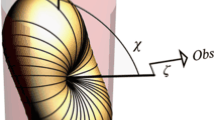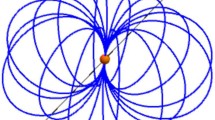Abstract
A modification of the rotating-star model has been developed to interpret the periodic energy bursts from pulsars. This new configuration involves θ-directed oscilltion modes in the stellar atmosphere or magnetosphere, and most aspects of the typical pulse characteristics are well accounted for. Gain is provided by resonant interactions with particles trapped in the stellar magnetic field. The most significant feature is the fact that highly directional beaming of the output energy results as a natural consequence of coherence between the radiation fields emerging from various locations about the pulsar; and a localized radiation origin is not required.
Similar content being viewed by others
References
Abramowitz, M. and Stegun, I. A.: 1964,Handbook of Mathematical Functions, Nat. Bur. Std. Appl. Math. Ser. 55, US Government Printing Office, Washington, D.C.
Altshuler, S.: 1974,J. Geophys. Res. 79, 3791.
Casperson, L. W.: 1975,J. Opt. Soc. Am. 65, 399.
Chiu, H. Y. and Canuto, V.: 1971,Astrophys. J. 163, 577.
Cocke, W. J. and Pacholczyk, A. G.: 1976,Astrophys. J. 204, L13.
Ginzburg, V. L., Zheleznyakov, V. V., and Zaitsev, V. V.: 1969,Astrophys. Space Sci. 4, 464.
Gold, T.: 1968,Nature 218, 731.
Gold, T.: 1972, in A. M. Lenchek (ed.)The Physics of Pulsars, Gordon and Breach, New York, p. 101.
Helliwell, R. A., Katsufrakis, J. P., Bell, T. F., and Raghuram, R.: 1975,J. Geophys. Res. 80, 4249.
Komesaroff, M. M.: 1970,Nature 225, 612.
Manchester, R. N., Taylor, J. H., and Huguenin, G. R.: 1975,Astrophys. J. 196, 83.
Mertz, L.: 1974,Astrophys. Space Sci. 30, 43.
Moffet, A. T.: 1971, in R. D. Davies and F. G. Smith (eds.),The Crab Nebula, D. Reidel, Dordrecht p. 195.
Oster, L.: 1975,Astrophys. J. 196, 571.
Pacini, F.: 1971, in R. D. Davies and F. G. Smith (eds.)The Crab Nebula, D. Reidel, Dordrecht, p. 394.
Ruderman, M. A. and Sutherland, P. G.: 1975,Astrophys. J. 196, 51.
Sturrock, P. A.: 1971,Astrophys. J. 164, 529.
Taylor, J. H. and Manchester, R. N.: 1975,Astron. J. 80, 794.
Tsuruta, S.: 1971, in R. D. Davies and F. G. Smith (eds.)The Crab Nebula, D. Reidel, Dordrecht, p. 352.
Van de Hulst, H. C.: 1957,Light Scattering by Small Particles, Wiley, New York, Sec. 13.3.
Zheleznyakov, V. V.: 1971,Astrophys. Space Sci. 13, 87.
Author information
Authors and Affiliations
Rights and permissions
About this article
Cite this article
Casperson, L.W. Coherent amplification and pulsar phenomena. Astrophys Space Sci 48, 389–399 (1977). https://doi.org/10.1007/BF00648125
Received:
Issue Date:
DOI: https://doi.org/10.1007/BF00648125




